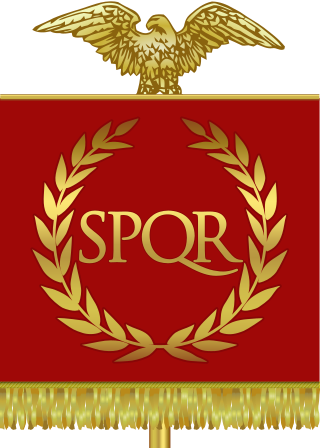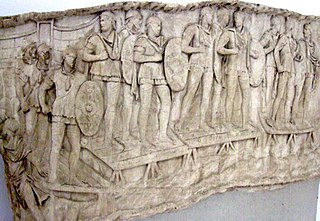Related Research Articles

The Roman legion, the largest military unit of the Roman army, comprised 4,200 infantry and 300 equites (cavalry) in the period of the Roman Republic and 5,600 infantry and 200 auxilia in the period of the Roman Empire.

The Praetorian Guard was an elite unit of the Imperial Roman army that served as personal bodyguards and intelligence agents for the Roman emperors.

The Revolt of the Batavi took place in the Roman province of Germania Inferior between AD 69 and 70. It was an uprising against the Roman Empire started by the Batavi, a small but militarily powerful Germanic tribe that inhabited Batavia, on the delta of the river Rhine. They were soon joined by the Celtic tribes from Gallia Belgica and some Germanic tribes.
A cohort was a standard tactical military unit of a Roman legion. Although the standard size changed with time and situation, it was generally composed of 480 soldiers. A cohort is considered to be the equivalent of a modern military battalion. The cohort replaced the maniple. From the late second century BC and until the middle of the third century AD, ten cohorts made up a legion. Cohorts were named "first cohort", "second cohort", etc. The first cohort consisted of experienced legionaries, while the legionaries in the tenth cohort were less experienced.

The Roman army was the armed forces deployed by the Romans throughout the duration of Ancient Rome, from the Roman Kingdom to the Roman Republic and the Roman Empire, and its medieval continuation, the Eastern Roman Empire. It is thus a term that may span approximately 2,205 years, during which the Roman armed forces underwent numerous permutations in size, composition, organisation, equipment and tactics, while conserving a core of lasting traditions.

The auxilia were introduced as non-citizen troops attached to the citizen legions by Augustus after his reorganisation of the Imperial Roman army from 27 BC. By the 2nd century, the Auxilia contained the same number of infantry as the legions and, in addition, provided almost all of the Roman army's cavalry and more specialised troops. The auxilia thus represented three-fifths of Rome's regular land forces at that time. Like their legionary counterparts, auxiliary recruits were mostly volunteers, not conscripts.

Vindomora was an auxiliary fort on Dere Street, in the province of Lower Britain. Its ruins, now known as Ebchester Roman Fort, are situated at Ebchester in the English county of Durham, to the north of Consett and 12 miles (19 km) west-south-west from Newcastle upon Tyne.

Centurion is a historical fiction novel (ISBN 0755327764) written by Simon Scarrow, published by Headline Book Publishing in 2007. It is book 8 in the Eagles of the Empire series, continuing Macro and Cato's adventures in the eastern provinces of the Roman Empire that began in The Eagle in the Sand.

The Alpine regiments of the Roman army were those auxiliary units of the army that were originally raised in the Alpine provinces of the Roman Empire: Tres Alpes, Raetia and Noricum. All these regions were inhabited by predominantly Rhaetian peoples and Celtic-speaking tribes. They were annexed, or at least occupied, by the emperor Augustus' forces during the period 25–14 BC. The term "Alpine" is used geographically in this context and does not necessarily imply that the regiments in question were specialised in mountain warfare. However, in the Julio-Claudian period, when the regiments were still largely composed of Alpine recruits, it is likely that they were especially adept at mountain operations.

This article concerns the Roman auxiliary regiments of the Principate period originally recruited in the western Alpine regions of the empire. The cohortes Alpinorum came from Tres Alpes, the three small Roman provinces of the western Alps, Alpes Maritimae, Alpes Cottiae and Alpes Graiae. The cohortes Ligurum were originally raised from the Ligures people of Alpes Maritimae and Liguria regio of NW Italia.

The Imperial Roman army was the military land force of the Roman Empire from 27 BC to 476 AD, and the final incarnation in the long history of the Roman army. This period is sometimes split into the Principate and the Dominate (284–476) periods.
Cohors VI Thracum quingenaria equitata was a Roman auxiliary regiment containing cavalry contingents. The cohort activated on Dacia and Moesia Inferior provinces. In Dacia the unit stationed on castra from the limes of Dacia Porolissensis: Porolissum, Certinae and Optatiana.
The Cohors XX Palmyrenorum was an auxiliary cohort of the Roman Imperial army. It was a cohors equitata milliaria, mixed infantry and cavalry regiment, originally recruited from the inhabitants of Palmyra in Roman Syria. There were also a small number (32–36) of dromedarii forces attached to the infantry.
Cohors [prima] Antiochensium [quingenaria] equitata was a Roman auxiliary regiment containing cavalry contingents. The cohort stationed in Dacia at castra Drobeta.
Cohors [prima] Aurelia Antonina Hemesenorum milliaria [peditata] was a Roman auxiliary infantry regiment. The cohort was stationed in Dacia at castra Micia.
Cohors [prima] Flavia Ulpia Hispanorum milliaria equitata civium Romanorum was a Roman auxiliary regiment containing cavalry contingents. The cohort stationed in Dacia at castra of Orheiu Bistriței and castra Napoca.
Cohors [prima] "Augusta Nervia Pacensis" / "Aurelia" / "Flavia Malvensis" Brittonum milliaria [peditata] was a Roman auxiliary infantry cohort. The cohort stationed in Dacia at castra Buridava, castra of Bumbești-Jiu (Gară) and Vârtop) and castra Malva.
Cohors I Ubiorum was a Roman auxiliary cohort. The cohort was at one point or another stationed at Calidava/Calidaua. The Cohors I Ubiorum was likely created during the reign of Augustus, and it is known to have been in existence during the reign of Domitian in the late 1st century AD. The unit likely played a role in maintaining Roman control over the area and in defending the Roman frontier against incursions by Germanic tribes. The cohort likely played a role in maintaining Roman control over the region.
Cohors Primae Vangionum Milliaria Equitata was a Roman auxiliary infantry cohort from Upper Germany with both horse and foot soldiers known as a cohors equitata, and nominally 1000 strong.
References
- ↑ Forty, Simon and Jonathan (2021). Limits of Empire - Rome's Borders. Casemate Publishers. p. 153. ISBN 9781636240770.